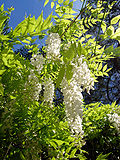Gibraltar Botanic Gardens

The Gibraltar Botanic Gardens commonly known as La Alameda Gardens are a botanical garden in Gibraltar, spanning around 15 acres. The Rock Hotel stands above the park.
History
In 1816 the gardens were commissioned by the Governor of Gibraltar, General George Don. It was his intention that the soldiers stationed in the fortress would have a pleasant recreational area to enjoy when off duty, and so inhabitants could enjoy the air protected from the extreme heat of the sun.[1]
The gardens were resurrected in 1991 by an external company when it was realised that since the 1970s they had fallen into a poor state. Three years later the gardens had the addition of a zoo: the Alameda Wildlife Conservation Park.[1]
In 2001 a bronze sculpture of James Joyce's Molly Bloom was installed in the gardens. This running figure was commissioned from Jon Searle to celebrate the bicentenary of the Gibraltar Chronicle in 2001.
The Eliott Memorial
General Don had commissioned a memorial of George Augustus Eliott, 1st Baron Heathfield, in 1815, which did not materialise in the form initially requested. A colossal statue of General Eliot, carved from the bowsprit of the Spanish ship San Juan Nepomuceno, taken at the Battle of Trafalgar, was first created. That statue was taken to the governor's residence, The Convent, where it stands today. This statue is guarded for four 18th-century howitzers.
Plants of the gardens

The plants of the Alameda Gardens are a combination of native species and others brought in from abroad:
- Dracaena draco (Canary Islands Dragon Tree), a subtropical Dragon Tree native to the Canary Islands, Cape Verde, Madeira, Azores, and locally in western Morocco. The oldest dragon tree in the gardens is about 300 years old.
- Stone pine (Pinus pinea), a species of pine native of southern Europe, primarily the Iberian Peninsula.
- Wild Olive (Olea europaea), a species of small tree in the family Oleaceae.
- Celtis australis (European Nettle Tree), a deciduous tree that can grow to 62 to 80 feet in height.
- Grevillea robusta (Australian Silk Oak), the largest species in the genus Grevillea. There is only one specimen of this tree in the gardens.[2]
- Canary Island Date Palm (Phoenix canariensis), a large palm native to the Canary Islands off the Atlantic coast of north Africa.
- Washingtonia filifera (Washingtonia), a palm native to the desert oases of Central, southern and south-western Arizona, southern Nevada, extreme northwest Mexico and inland deserts of southern California.
- Howea forsteriana (Kentia palm), endemic to Lord Howe Island.
- Ptychosperma elegans (Solitaire Palm), endemic to the Northern Territory and eastern Queensland in Australia.
- Chinese hibiscus (Hibiscus rosa-sinensis), an evergreen shrub native to East Asia.
- Bougainvillea, a genus of flowering plants native to South America from Brazil west to Peru and south to southern Argentina (Chubut Province).
- Asteraceae (daisies), the second largest family of flowering plants.
- Pelargonium, a genus of flowering plants.
- Succulent plant, water-retaining plants adapted to arid climate or soil conditions.
Events
The Alameda Open Air Theatre was inaugurated once again on 12 April 1996 at four o'clock with three bands of music playing - the same number of bands as had attended 180 years before to the hour at the opening of the Alameda Gardens in 1816. In order to extend its use from just theatre to general use, a number of new features were introduced, like the waterfall and lake - the largest area of open fresh water on the Rock, with Koi Carp and a collection of exotic lilies.
Since its opening, this venue has been used for a variety of purposes, from beauty contests to band concerts, also weddings, dinner dances, conferences and variety shows. It also is the main venue for the GIB Fringe.
The theatre is available for hire and all proceeds will go directly into continued improvements in the theatre and in the rest of Gibraltar's historic and rapidly improving Alameda Gardens.
Pictures
-
Wisteria sinensis (Chinese Wisteria) in the gardens
-
Castle and key set in the lawn of The Dell
-
Wooden bridge in the Africa beds
-
British-style red telephone box
-
An evening stroll in the 19th century
-
Duke of Wellington's memorial
-
Whalebone arch
Outside links
| ("Wikimedia Commons" has material about Gibraltar Botanic Gardens) |
- Location map: 36°7’53"N, 5°21’4"W
- The Botanic Gardens - La Almeda






